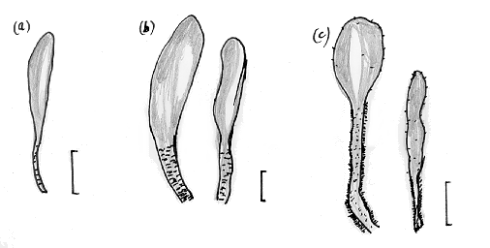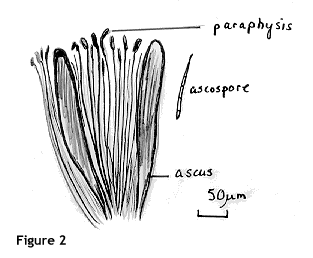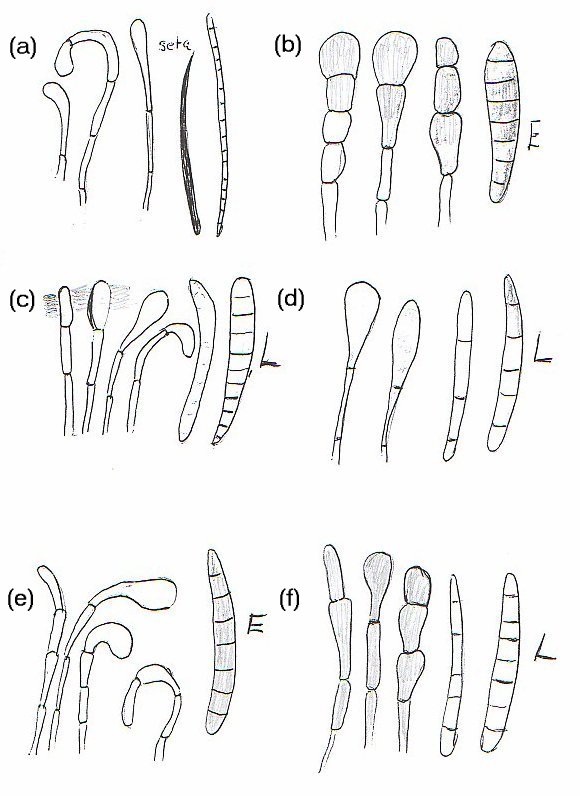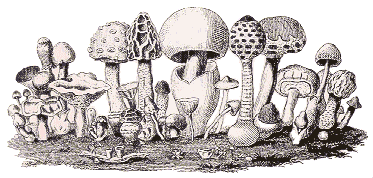Earth Tongues share with waxcaps and entolomas the distinction of being included in the Waxcap Grassland Survey (Rotheroe et al., 1996), which aims to identify nutrient-poor grasslands that are important for conservation. Although charming in their way, Earth Tongues are hardly in the waxcap glamour league: they look like miniature pokers or lollipops, which are not easy to see and almost certainly under-recorded. So for people who are not familiar with Earth Tongues, it seemed worthwhile to introduce the group, and perhaps stimulate more searching and recording.
Some typical Earth Tongues are shown in Figure 1. They are black, dark brown or olive green ascomycetes, classed as discomycetes because the fertile layer is on the outside.. Most are 3-6 cm tall (but can reach 7-10 cm) with a slightly expanded upper part (the fertile head) above a stem. The fruitbody, especially the head, is often flattened and usually appears smooth to the naked eye, sometimes with a slightly bristly or rough stem. These typical types are grouped in the genera Geoglossum, Trichoglossum and Microglossum (although you may find the names Thuemenidium and Corynetes used in older literature) in the family Geoglossaceae.

Figure 1 Examples of Earth Tongue fruitbodies. (a) Geoglossum fallax; (b) Geoglossum cookeianum; (c) Trichoglossum hirsutum. Scale bars are 1 cm.
Earth Tongues are mostly late autumn fungi, usually appearing in October and lasting well into November unless cut down by frosts. All grow on soil, nearly always in short grass or moss (including Sphagnum) and, in my experience, if grazing or mowing is relaxed or any sort of ‘thatch’ builds up, they soon disappear from an area. Soil type ranges from sandy (including dunes) to heavy, wet clay and Sphagnum peat, but is always poor in nutrients.
There are a number of points to bear in mind when collecting Earth Tongues. Two or three species often grow close together in one patch so it is essential to keep in separate containers the samples from different clumps, to be sorted out later with a microscope. You can do a little sorting in the field: Geoglossum glutinosum is the only common British species that is viscid, for example; Microglossum species are olive green or brown (all others being blackish) and Trichoglossum species have a distinctly bristly stem, which is just about visible by eye. But to distinguish reliably between species, microscopic examination is essential and it is important (for reasons that will be obvious from the key) that you have fully mature specimens: a tatty old fruitbody may be more useful than a neat young one. Finally, you really do need to search for Earth Tongues: a neighbour of mine recently overlooked completely a fine colony of Geoglossum glutinosum on her lawn, even though there were dozens of fruitbodies!
Regarding keys, five years ago the best available key plus descriptions of Earth Tongues was Nannfeldt (1942), with a limited number of species described in Dennis (1981) and Breitenbach and Kränzlin (1996). So I produced a simple key for the North West Fungus Group based on Nannfeldt and my own observations, supported by advice from Alan Silverside, who probably knows more about Earth Tongues in the UK than anyone else. Things have improved considerably since 1997, however, with a comprehensive key in Volume 1 of Nordic Macromycetes (Hansen and Knudsen, 2000) and a very useful draft key plus descriptions produced by Alan Silverside for use in the Waxcap Grassland survey. This last key incorporates Alan’s views about excluded or problematic species and is still in a draft, not-for-publication form so, as an interim measure, here is a simplified key based on all the above sources plus my own observations and some guidance about microscopical examination intended to help absolute beginners.
Microscopical examination
You need a microscope with low and high power objectives (x10 and x40) and a calibrated eye-piece micrometer scale with which to measure sizes. The asci lie at right angles to the surface of the head and so you need to remove a sliver of material with a sharp blade, small enough to squash out completely but not so shallow that it cuts through asci. Mount this sliver in water or dilute alkali so that the colours of structures can be seen but, if the cell walls are unclear, a second mount in ammoniacal Congo red can be helpful. Squash the sample lightly and have a preliminary look under low power. You should be able to see (Figure 2);
• asci - elongated sacs with spores inside;
• ascospores - inside and outside asci, elongated and just visible. If possible, obtain a spore deposit and examine this separately under high power;
• paraphyses - hyphae between the asci, often swollen at the tips. Notice whether the paraphyses are about the same length as asci or much longer, whether they are colourless or brown, and whether they appear to be stuck together (agglutinated) and mixed with brown ‘goo’ (politely described as amorphous material).

Now squash the sample really hard so that all structures are well-separated and examine under high power. The things to observe and measure (and preferably sketch, which makes one look very carefully) are:
• Setae: these are dark-brown, stiff bristles, about the same length as asci (150-180 µm) and lie among the paraphyses. They occur only in species of Trichoglossum.
• Ascospores: in Geoglossum and Trichoglossum, these are always long and thin, sometimes slightly curved (like a banana), with varying numbers of septa (which may not form until late in spore maturation). Measure spore length and width and count septa, noting if they form early or late, i.e. in young fruitbodies are there numerous spores where septa are still forming . With two exceptions, spores of these genera are dark-coloured when mature but may stay pale until a late stage, so note whether they colour up early or late by comparing young and old specimens. Spores of Microglossum are shorter and uncoloured.
• Paraphyses: notice whether they look coloured, whether straight or curled/twisted at the tip, the amount and size of any apical swelling and whether there are chains of swollen cells at the tip or any agglutination. They are often very variable and sorting out a description is not always easy; degree of agglutination, for example, can be unclear after firm squashing.
In the following key square brackets [ ] mean that I have not found this species myself and any descriptions are based on the observations of others.
Key to Earth Tongues in the UK
1. Black with bristles (projecting setae) on the stem and setae among asci Trichoglossum 4
1. Black, brown or green; lacking setae 2
2. Olive green or brown or reddish brown; spores colourless, <25 µm Microglossum 6
2. Black or dark brown; spores dark or colourless and mostly >25µm, Geoglossum 7
4. Mature spores mostly with 15 septa; widespread Trichoglossum hirsutum
[identical but with 4 instead of 8 spores per ascus = T. tetrasporum; rare?]
4. Mature spores with fewer than 15 septa 5
5. Mature spores with 9 to 14 septa (variable); rare [Trichoglossum variabile]
6. Stem smooth, often brownish; grasslands, often close to trees or shrubs, rare Microglossum olivaceum
6. Stem rough, scurfy or scaly, green; woodland, widespread Microglossum viride
7. Mature spores colourless, <40 µm 8
7. Mature spores dark, >40 µm 9
8. Spores aseptate; on acid, sand (dunes etc .), often with Calluna, Empetrum, Vaccinium; no or v. short, rough stem; [Geoglossum arenarium]
8. Spores tardily 6-septate; in short turf or moss (acid or base-rich); clear, finely scaly stem; [Geoglossum atropurpureum]
9. Whole fruitbody covered with a viscous, sticky layer; horny when dry; 10
9. Fruitbody not viscid; may be dry or moist 11
10. Spores develop colour and septa late in development; lollipop-type parahyses (Figure 3d); in acid turf; widespread Geoglossum glutinosum
10. Spores develop colour and septa early; paraphyses variable (many as Fig. 3f), in acid bogs, Sphagnum etc.; rare or overlooked [Geoglossum uliginosum]
11. From an early stage, spores simultaneously dark and 7-septate 12
11. Spores become dark and septate late in development; may have more or fewer than 7 septa 15
12. Paraphyses terminate in chains of swollen, barrel-shaped cells, strongly constricted at many septa; tips straight (Fig. 3b) 13
12. Paraphyses terminate in chains of elongated cells not or somewhat constricted at septa; tips curved, twisted or straight (Fig. 3c,e and f) ) 14
13. Robust fruitbodies with broad, flattened head and short stem; paraphyses barely exceeding asci; widespread on dunes and grasslands Geoglossum cookeianum
13. Slender fruitbodies with a relatively long, rugose stem; paraphyses much longer than asci; in Sphagnum and wet, acid grassland Geoglossum simile
14. Most paraphyses without a swollen terminal cell and with tips curved like a hockey stick (Fig. 3e); widespread in short turf Geoglossum umbratile
14. Most paraphyses with a swollen and twisted (circinate) apical cell (possibly only an extreme form of G. umbratile) Geoglossum barlae
15. Mature spores with 7 or fewer septa; paraphyses straight, coloured, agglutinated in brown material ,often with a swollen apical cell or chains of elongated pyriform cells (Fig. 3f); stem with felty tufts which rub off later Geoglossum vleugelianum
15. Mature spores with 7 or more septa; paraphyses mostly curved (Fig. 3c and e) 16
16. Paraphyses pale coloured or colourless with tips embedded in brown amorphous material, often swollen at apex; spores with up to 12 septa and 70-105 µm (Fig. 3c). Widespread in short grass or moss Geoglossum fallax
16. Paraphyses distinctly coloured, usually not embedded nor swollen at apex (similar to left side of Fig. 3e); spores with up to 9 septa and usually not exceeding 85µm; rare, Scotland only? [Geoglossum starbaeckii]
Notes on species
TRICHOGLOSSUM
Trichoglossum hirsutum (Pers ex Fr.) Boud. (Figs 1c and 3a).
This is by far the most common British species in the genus, found on dunes and in neutral or acid grassland in both lowlands and uplands. Fruitbodies are black, 2.5-9cm and with stiff bristly hairs on the stem, visible by eye. The head is quite often abruptly swollen and flattened so that the whole looks like a lolllipop. Asci are up to 220 µm with long, slender 15-septate spores, 113-140 µm. Paraphyses are slender, septate, with slightly swollen apical cells that are usually curved (like a hockey stick). The opaque, black setae, 110-180 µm, have a pointed end.
Trichoglossum walteri (Berk.) Durand.
Found by me in acid, grazed grassland at a lowland site but rarely recorded and seems to be mostly in the north and west. Fruitbodies 5-9 cm, black with the flattened head (2-2.5 cm) clearly delimited and with a grooved, rather granular surface. Stem very felty-hairy an more brown in colour. Spores are 7-septate (occasionally 8) and are supposed to be 90-95 µm, never exceeding 100 µm but in my collections they did. Paraphyses and setae are as in
T. hirsutum.
Other species which might be expected are:
Trichoglossum tetrasporum Sinden & Fitzpat.
This seems to be identical to T. hirsutum except that asci contain only four (not eight) spores.
Trichoglossum variabile (Durand) Nannf.
Said by Ellis & Ellis to be found on boggy ground with Dryas. Apparently identical to
T. hirsutum except that the spores have a variable number of septa, between 11 and 14.
MICROGLOSSUM
Microglossum olivaceum (Pers.:Fr.) Gillet
A red data list species, said to occur in base-rich grassland and woodlands. Material I have seen or found was on acid, mossy dunes with Calluna (Cornwall) and acid upland pasture bordering woodland (Cumbria). The fertile head is greenish brown (or, rarely, carmine) and the stem smooth and yellowish. Asci are 90-100 µm and the colourless ascospores 13-18 x 4-5 µm with up to three septa when mature (rather tardily septate). Paraphyses are filiform, often branched and sometimes slightly expanded at the apices.
Microglossum viride (Pers.:Fr.) Gillet
This is definitely a woodland species and relatively common. Compared with M. olivaceum the fertile head is more distinctly green and the brown stem is rough, ranging from furfuraceous to coarsely green-scaly. Asci can be up to 150 µm and ascospores and paraphyses are similar to those of M. olivaceum or, for spores, somewhat larger (15-21 x 5-6 µm and up to three or four-septate).
GEOGLOSSUM
Geoglossum cookeianum Nannf. (Figs. 1b and 3b)
A species found in both short acid grassland and on fixed dunes. It is said to be common on sandy soils. The blackish fruitbodies are usually rather sturdy with the fertile head occupying half or more of the total length and merging gradually with the stem. Height varies between 2 and 9 cm. The surface is finely furfuraceous, especially when young, with the stem appearing rugose or scurfy and more brown in colour. Asci (139-186 µm) have banana-shaped ascospores, narrower at one end, that become dark brown and 7-septate early in development. Spore lengths ranged from 52-71 with the majority between 61 to 65 µm (12 collections). Paraphyses are the same length or slightly longer than the asci, straight, colourless with well-spaced septa in the lower part and, at the tip, a chain of pale brown, swollen, pear-shaped or barrel-shaped cells, constricted at the septa. Occasionally they branch near the tip and the chains of cells are quite variable in appearance, often having unswollen cells between swollen cells. Nannfeldt states that the paraphyses are aggluginated in clumps but only once have I ever seen this clearly. I have also found (four collections) a species very like cookeianum but with longer spores (63-87, average 74.5µm) and with the paraphyses much longer than the asci. This matches a species described by Nannfeldt as
G. simile - which was thought to occur only in Asia and North America but is now listed as a British species.
Geoglossum fallax Durand. (Figs. 1a and 3c)
Found in lowland acid pasture (short grass and moss) and upland acid grassland, mostly in disturbed sites with bare soil, lichens and mosses. Fruitbodies 3-6.5cm, generally slender with a black head (1-2.5cm), felty when young and later smooth, pitted. Stem brown with a rugose surface, often tufts of fine hairs in rows (‘permed’ look). Asci 170-225µm. Ascospores long, slender, straight or slightly curved, tardily septate and coloured, 82-115 (mean 96.2 + 6.6, seven collections); septa range from 0 to 13. Paraphyses hyaline or very pale brown, septate, often (but not always) with a clearly swollen apical cell, often (but not always) curved at the apex and sometimes (but rarely) constricted at the uppermost septa. They are supposed to be strongly agglutinated with the tips surrounded by a brown matrix; both characters were often unclear to me.
Geoglossum glutinosum Pers. ex Fries. (Fig. 3d)
The only common glutinous species (but see G.uliginosum below). Ellis & Ellis describe a glutinous species called G. viscosum but this is not described in Nannfeldt and does not exist according to Alan Silverside. Found in short acid grassland in the uplands and lowlands (including mossy lawns). Fruitbodies 2.6-6.5; head 1.5cm, black with scattered bristly hairs; stem brown. Glutinous-viscous all over when young; later the head dries but the stem remains glutinous. Asci long, 212-270µm. Ascospores tardily septate and coloured; with 0-3 septa, 75-84 (mean 74.8) µm, when older with mostly 7 septa, 81-100, (mean 93.1). Paraphyses straight, longer than the asci, pale brown or colourless, septate (which contradicts Ellis & Ellis) with the terminal cell often abruptly swollen (up to 9.4µm); this terminal cell may develop an apical pimple which develops into a second swollen cell in very mature specimens, so tips can look quite irregular. Occasionally saw a brown matrix, which is supposed to be present.
Geoglossum umbratile Sacc (G. nigritum (Pers. ex Fries) Cooke). (Fig. 3e)
Found by me only at upland sites in short, poorly-drained grass with moss and lichens. 7 collections. A very variable species - often difficult to be certain of identification. Fruitbodies 3-10cm; head blackish with short, scattered stiff hairs and pitted surface when old, tapering gradually downwards; stem brownish, rugose. Asci 162 + 8; ascospores 61-87 (mean 74.8 + 11.6), usually dark and 7-septate, quite early. Nannfeldt describes the extreme spore variation with mean lengths from 59 to 87 in different collections. Paraphyses pale brown, usually show some apical curvature, with the apical cell most swollen above a chain of elongated cells, usually with little or no constriction at the septa.
G. fallax has longer spores and G. vleugelianum usually has paraphyses with constrictions at the septa, no apical curvature and shorter spores.
Geoglossum barlae (Boud).
Is possibly only an extreme form of G. umbratile but the apical cell of paraphyses is typically swollen and very strongly hooked or even circinate (coiled). Material matching this description was found on the BMS foray to Fermanagh, Northern Ireland, in 2000 – on mossy ground in dense woodland!
Geoglossum vleugelianum Nannf. (Fig. 3f)
This species is still not officially on the British list but was tentatively identified by Alan Silverside in material which I sent to him and confirmed in material from Derbyshire. According to Nannfeldt, the species has spores that are tardily coloured and septate, 7 septa at maturity, (40) 50-60 µm, and stout, straight paraphyses that are dark to the base, agglutinated to some degree and have a swollen apical cell (globose or pyriform). His drawing of paraphyses shows one that has an apical chain of pyriform swollen cells. The stem has tufts of black hyphae which rub off with age, leaving a smooth black surface. The seven collections I found were all in short, acid grassland in the uplands and agreed generally with this description but the spores were larger (53-70, mean = 61.5 + 6.3µm). The paraphyses commonly had chains of pyriform cells at the apex and some resembled more closely
G. cookeianum. Most of these specimens were old and nearly all spores were dark with 7 septa.
Species which I have not found are:
Geoglossum arenarium (Rostr.) Lloyd. (Microglossum a., Corynetes arenarius, C. geoglossoides)
A rare species found on acid dunes or other sandy sites together with heath species (Calluna, Empetrum, Vaccinium). The black fruitbody has a short, rough stem. Asci are 130-160 µm, ascospores colourless, 25-40 x 4-6 µm and aseptate, and paraphyses are dark brown, curved or straight with a swollen apical cell.
Geoglossum atropurpureum Batsch : Fr. (Thuemidium a., Corynetes atropurpreus)
Silverside has now placed this species in Microglossum. Reported to occur in base-rich turf, meadows and forests, and acid heath-like areas with Polytrichum mosses. The black fruitbodies (up to 9 cm) have a short, slightly roughened stem. Asci are 100-120 µm; ascospores colourless, 20-35 x 5-6 µm and, tardily, up to 9-septate; and paraphyses slender, straight, and sometimes with swollen tips which, according to some authors, contain dark brown material and to others are hyaline but embedded in amorphous, dark brown matter.
Geoglossum elongatum Starb.
The main distinguishing feature of this (apparently rare) species is the paraphyses which (from Nannfeldt) have very irregular tips - swollen, curved and lobed, pale but agglutinated in a dark matrix; according to Silverside, paraphyses may also be as in the left side of Fig. 3c, i.e. straight and lacking a swollen terminal cell. Spores are tardily septate with up to 7 septa (but often only three or four present) and 50-60 x 5-7 µm.
Geoglossum starbaeckii Nannf.
According to Dennis this species is common on acid Highland soils. The most distinctinctive feature (from Nannfeldt) is the extremely numerous, slender, dark paraphyses, which have mostly curved tips, slightly swollen, elongated cells (similar to Fig. 3e) and are not agglutinated. Spores are tardily septate, with 7 or more septa, irregularly spaced. It seems to have been confused with G. umbratile in the past (the paraphyses are similar) but this last species has spores that are regularly 7-septate and dark early in development.
Geoglossum uliginosum
A rare species of Sphagnum and other boggy places with slender, viscid fruitbodies. Spores are 7-septate with early darkening and septation and paraphyses mainly straight, with no or limited constrictions at septa and apical swelling (as in the left side of Fig. 3e.
References
Breitenbach, J. and Kränzlin, F. (1984) Fungi of Switzerland. Volume 1 Ascomycetes. Verrlag Mykologia, Lucerne.
Dennis, R.W.G. (1981) British Ascomycetes. 3rd ed. J. Cramer, Vaduz.
Ellis, M.B. and Ellis, J.P. (1988) Microfungi on miscellaneous substrates. An identification handbook. Croon Helm, London.
Hansen, L. and Knudsen, H. (eds) (2000) Nordic Macromycetes Volume 1 Ascomycetes. Nordsvamp, Copenhagen.
Nannfeldt, J.A. (1942) The Geoglossaceae of Sweden. Archiv för Botanik 30A (4), 1-67.
Rotheroe, M., Newton, A., Evans, S. and Feehan, J. (1996) Waxcap-grassland survey. Mycologist 10, 23-25.

Figure 3 Paraphyses (on left) and ascospores (on right) drawn from own material. L or E indicate that spore septation and colouring occurred Late or Early in development. Approximately x 600.
(a) Trichoglossum hirsutum (b) Geoglossum cookeianum (c) Geoglossum fallax
(d) Geoglossum glutinosum (e) Geoglossum umbratile (f) Geoglossum vleugelianum
